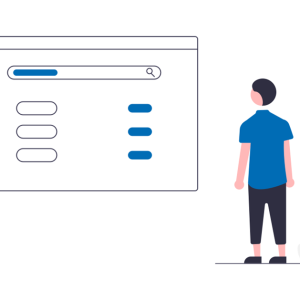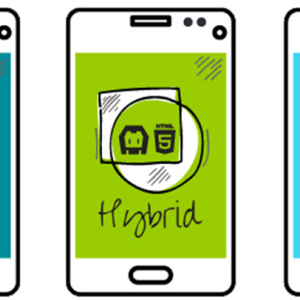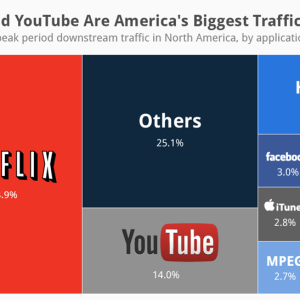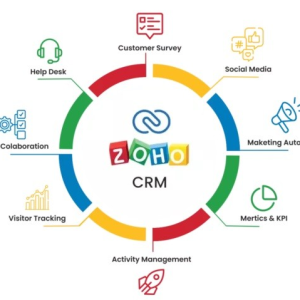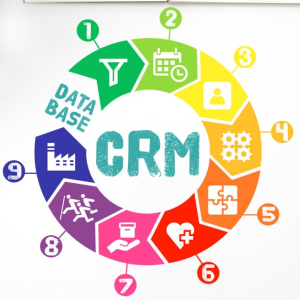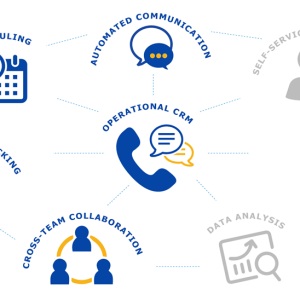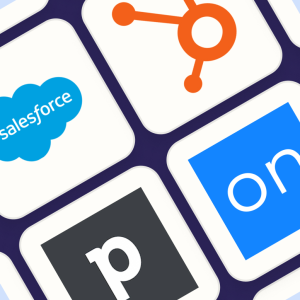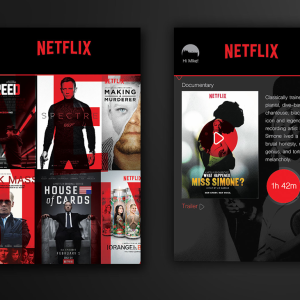Introduction
CRM software gives back an average ROI of $8.71 for every dollar spent. (Source: Adam Enfroy)
Mobile apps are expected to generate over $935 billion in revenue by 2023. (Source: Statista)
Website is the #2 channel used in marketing, behind social media (Source: HubSpot)
Developing a website, mobile application, or CRM system can be a daunting task. There are many different ways to develop these systems, and there are also many mistakes that can be made during the development process. This article will outline some of the most common mistakes made during mobile application development, website development, and CRM development, and will offer tips on how to avoid them.
5 Common mistakes made during Mobile Application Development

Mistake #1: Developing Applications for the Wrong Platform
One of the most common mistakes made during mobile application development is developing applications for the wrong platform. For example, if you are developing an Android application, you should not develop it using iOS development tools. The same is true for iOS applications – they should be developed using iOS development tools, not Android development tools. This seems like a simple mistake to avoid, but it can often be overlooked in the early stages of development.
Mistake #2: Not Optimizing for Different Screen Sizes
Another common mistake made during mobile application development is not optimizing applications for different screen sizes. With a large number of different Android devices on the market, it is important to make sure that your application is optimized for all screen sizes. This can often be accomplished by creating multiple layouts for different screen sizes or by using responsive design techniques.
Mistake #3: Not Testing on Multiple Devices
A third common mistake made during mobile application development is not testing applications on multiple devices. It is important to test your application on as many different devices as possible, including both smartphones and tablets. This will ensure that your application works properly on all devices and will help you to identify any potential issues.
Mistake #4: Not Utilizing the Full Capabilities of the Device
Another mistake that is often made during mobile application development is not utilizing the full capabilities of the device. Mobile devices are powerful computers, and they are capable of much more than just running applications. Make sure to take advantage of the camera, GPS, and other features of the device when developing your application.
Mistake #5: Not Incorporating Feedback from Users
Another common mistake made during mobile application development is not incorporating user feedback into your application. By soliciting feedback from users throughout the development process, you can ensure that your application meets their needs and expectations. This will help to improve the overall quality of your application and increase the likelihood of its success.
While many potential mistakes can be made during mobile application development, these are some of the most common. By avoiding these mistakes, you can help to ensure the success of your project.
10 Common Mistakes Made During Website Development

Mistake #1: Not planning ahead
One of the most common mistakes made during website development is not planning. This can result in a website that is not well designed, is difficult to use, or does not meet the needs of the users.
Mistake #2: Not designing for users
Another common mistake is not designing the website for users. This can mean that the website is difficult to navigate, does not have the information that users are looking for, or is not visually appealing.
Mistake #3: Not testing the website
A common mistake made during website development is not testing the website before it is launched. This can result in errors and bugs that can make the website unusable.
Mistake #4: Not using proper coding standards
Another mistake that can be made during website development is not using proper coding standards. This can make the website more difficult to maintain and could lead to security vulnerabilities.
Mistake #5: Not optimizing for search engines
A common mistake made during website development is not optimizing the website for search engines. This can make it difficult for users to find the website when they search for it online.
Mistake #6: Not considering scalability
Another mistake that can be made during website development is not considering scalability. This can limit the growth of the website and make it more difficult to add new features or functionality in the future.
Mistake #7: Not securing the website
A common mistake made during website development is not securing the website. This can leave the website vulnerable to attacks from hackers or malware.
Mistake #8: Not using proper web hosting
Another mistake that can be made during website development is not using proper web hosting. This can make the website slow to load or cause it to crash.
Mistake #9: Not making the website mobile friendly
A common mistake made during website development is not making the website mobile-friendly. This can make it difficult for users to view the website on their mobile devices.
Mistake #10: Not monitoring the website
A common mistake made during website development is not monitoring the website after it has been launched. This can lead to issues with performance or security that could impact the user experience.
If you are planning to develop a website, it is important to avoid these common mistakes to ensure that your website is successful and provides a positive user experience for your users. By taking the time to plan your website carefully and test it thoroughly before launching it, you can avoid these common mistakes and create a successful website.
5 Common mistakes made during CRM Development

Mistake #1: Not planning properly
One of the most common mistakes made during CRM development is not planning properly. This can lead to missed deadlines, budget overruns, and other problems. Make sure to plan out the project thoroughly and allocate enough time for each step of the process.
Mistake #2: Focusing on features instead of functionality
Another common mistake during CRM development is focusing too much on the features of the system, instead of its functionality. This can lead to software that doesn’t meet users’ needs or that doesn’t work well with other systems in your organization. It’s important to ensure that the CRM system you choose provides the functionality your users need and will work well with other systems in your organization.
Mistake #3: Not investing in quality testing
To avoid common CRM development mistakes, it’s also important to invest in high-quality testing of the system throughout the development process. This can help you catch errors and issues before they become too costly or difficult to fix later on. Some effective testing strategies include unit testing, integration testing, and user acceptance testing.
Mistake #4: Developing for the wrong platform
Another mistake that’s often made during CRM development is developing for the wrong platform. This can happen if you choose a CRM system that’s not compatible with the systems your organization uses, or if you try to develop a system that’s too complex or advanced for your organization’s needs. It’s important to choose a CRM system that will be compatible with the platforms you use and to develop a system that meets your users’ needs without being overly complex.
Mistake #5: Failing to consider user feedback
Finally, one of the most common mistakes during CRM development is failing to consider user feedback. This can lead to software that’s difficult to use or that doesn’t include features that your users need. It’s important to get feedback from users throughout the development process and to use that feedback to improve the system.
Avoiding these common mistakes during CRM development can help you create a system that meets your users’ needs and works well with other systems in your organization. By investing in quality testing, focusing on functionality over features, and considering user feedback, you can create a high-quality CRM system that helps you achieve your business goals.
Learning from Real-life Examples of These Failed Businesses
Businesses that failed using the website and Why?
Businesses can fail to use websites for a variety of reasons. Perhaps the website was not designed well and was difficult to use, or maybe the website was not updated regularly and became out of date. In some cases, businesses may have chosen the wrong platform to build their website on, or they may not have invested enough money in their website design and development. Whatever the reason, failing to have a website that is effective and up-to-date can be detrimental to a business.
Example
For example, one company that failed with its website was a small-town bakery. The bakery had set up a website to advertise its products and promote sales, but the site was outdated and poorly designed. This led many potential customers to believe that the business was not successful or unable to keep up with changing trends in the baking industry, which may have dissuaded them from trying the bakery’s products. Additionally, the site was difficult to navigate, which meant that potential customers might have been discouraged from exploring it further.
Some of the best ways to avoid making these mistakes with your website include investing in a quality web developer who understands how to create an effective and engaging user experience, ensuring that your website is updated regularly with new content and products, and choosing the right platform to build your website on. Additionally, it’s important to consider all of your customers when designing your site, particularly if you are targeting a younger audience or have an online presence that is meant to attract customers from around the world.
Businesses that failed using Mobile Application and Why?
Businesses that have failed to use mobile applications typically did not take the time to properly design and test their applications. In addition, they did not make the necessary adjustments to their marketing and advertising efforts to target mobile users. Finally, they did not create a strategy for retaining users.
Examples
Two examples of businesses that failed using mobile applications are Toys “R” Us and Blockbuster.
Toys “R” Us failed to create a mobile application that was able to compete with Amazon, eBay, and Walmart. The application was difficult to use, did not offer any unique features, and was not well-promoted. As a result, customers turned to other retailers for their mobile shopping needs.
Blockbuster also failed to create a successful mobile application. The app was buggy, difficult to use, and did not offer any compelling features. As a result, customers turned to Netflix and other streaming services for their movie-watching needs.
To avoid making the same mistakes as these businesses, it is important to create a user-friendly mobile application that offers unique features and is well-promoted. Additionally, it is important to test the app thoroughly before launch to ensure that there are no bugs or errors.
Businesses that failed using CRM and Why?
Businesses that have failed in the past often did so because they did not choose the right CRM system. There are a few key things to look for when choosing a CRM system:
1. Does the CRM system fit your business?
2. Is the CRM system easy to use?
3. Is the CRM system customizable?
4. Is the CRM system affordable?
5. Is the CRM system scalable?
6. Does the CRM system have a good support team?
7. Does the CRM system integrate with other systems?
If you can answer yes to all of these questions, then you are likely choosing a good CRM system. However, if you answer no to any of these questions, then you may want to consider another CRM system.
Examples
Two businesses that failed using CRM are the clothing retailer Abercrombie & Fitch and the restaurant chain Chipotle.
Abercrombie & Fitch failed to use CRM effectively because they did not track customer data or preferences. As a result, they were unable to personalize their marketing efforts or target customers with relevant products or promotions. This ultimately resulted in poor sales performance and a decline in profits.
Chipotle also struggled with CRM because it lacked the necessary tools to manage customer interactions. For example, they did not have any centralized systems for tracking orders, returns, or customer preferences. Without this data, Chipotle was unable to provide personalized service to customers or keep track of their buying habits. This ultimately resulted in disappointing sales numbers and customer dissatisfaction.
To avoid these mistakes, businesses should invest in modern CRM tools that can help them collect, analyze, and act on customer data. Additionally, they should be sure to integrate their CRM solution with other business systems such as marketing automation software and order management software. By doing so, businesses can ensure that their CRM efforts are more effective and provide a better customer experience.
In summary, there are several common mistakes that businesses may encounter when using CRM technology. These include failing to track customer data or preferences, not using modern CRM solutions, and not integrating CRM with other business systems. By avoiding these mistakes, businesses can improve their sales performance and provide a better customer experience.
Conclusion
Mistakes can be costly during the website, mobile application, and CRM development process. To avoid them, it is important to have a clear understanding of the development process and what needs to be done to create a successful product. This article has outlined some of the most common mistakes made during mobile application development, website development, and CRM development, and has offered tips on how to avoid them. By following these tips, you can help ensure that your product is developed successfully and avoid costly mistakes.
We know that this will be an amazing project for us both, and we’ll have lots of fun developing your marketing strategy as well!
12 Channels is much more than just your partner in marketing. We’re an integral part of building the future for companies across all industries and sectors, by providing award-winning service that gets customers engaging with what you have to offer!


